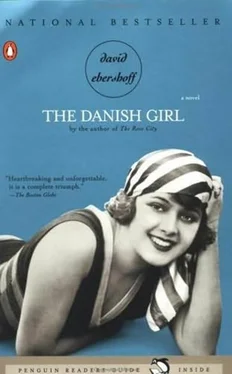Greta never told Einar much about Teddy Cross. She had returned to Denmark on Armistice Day, a widow for six months, her name again Greta Waud. He died for no good reason at all, she would say when friends asked about her first husband. After all, Greta would think, dying when you’re twenty-four and live in California’s clean dry heat is the result of just that: the cruelty of the world. It made no sense, really. Certainly Teddy didn’t have a Western spine, another unjust fate. Sometimes she ’d also think, with her eyes sealed to stem the regret: perhaps she and Teddy were never meant to be married. Perhaps his love for her was never as great as hers for him.
Greta and Lili were almost at the restaurant when she stopped Lili and said, “Don’t be angry with me, but I have a little surprise for you.” She pushed Lili’s bangs out of her eyes. “I’m sorry for not telling you earlier, but I thought it ’d be easier for you to hear about it just before.”
“Hear about what?”
“That we ’re having dinner with Hans.”
Lili’s face went white, and it was clear that she understood. She pressed her forehead against the window of a closed charcuterie. Inside, skinned piglets were hanging from a rope like pink pennants. Even so, Lili asked, “Hans who?”
“Come on now. No panicking. It’s Hans. He wants to see you.”
The Parisian critic with the wart on the rim of his eye had quickly answered Greta’s letter, sending Hans’s address and a further inquiry about Greta’s painting. The attention from the critic nearly threw Greta into a reverie. Paris was asking after her art! she told herself, opening her box of stationery from Århus and filling her pen with ink. First she wrote the critic: Is there a life for me in Paris? she asked. Should my husband and I consider leaving Denmark, where no one knows what to think of me? Would our lives be freer in Paris?
Then Greta wrote Hans: My husband seems never to have forgotten you, she began. When he is dreaming at his easel, I know he is thinking of you hanging from the oak above the bog. His face softens and nearly shrinks. It is as if he is becoming thirteen again, with shiny eyes and a smooth chin.
Now in his mid-thirties, Hans Axgil had a thin nose and wrists covered with a dense blond hair. He had become a large, sturdy man, his neck rising thick out of his chest; it made Greta think of the old sycamore stump at the rear of her California garden. Einar had described Hans as small, the runt of the bog. His nickname had been Val nød, or walnut; some said it was because in the summer his skin turned pale brown, as if dimly soiled from Bluetooth’s perpetual mud, a pool of which had served as his birth bed when his mother’s coach, overturned in a hailstorm, stranded her and her two maids on a heath with nothing but matchlight and the driver’s canvas coat offered as a nativity tarp.
Now of course Hans was a man, large in a Germanic way. He shook other people’s hands with both of his; those same hands often hooked together at the nape of his neck when he was telling a story. He drank nothing but champagne or water with gas. He dined only on fish, having once eaten a venison chop and then lost his appetite for a month. He was an art dealer, shepherding Dutch masters to rich Americans who collected for the sake of amassing. It was a business, he described, with a smile revealing two incisors like drills, as often immoral. “Not always, but often enough,” he said. Hans’s favorite sport was still tennis. “The best part of France is its terre battue. The red clay. The white tennis balls with the gummy seams. The umpire sitting up in his chair.”
The restaurant was across the road from the harbor. There were eight tables on the sidewalk, beneath striped parasols anchored in tins of rocks. In the harbor, sailboats were arriving home. Brits on holiday stood on the docks, holding hands, the backs of their knees sunburned. On the restaurant ’s tables were vases of marigolds, and sheets of white paper protecting the cloth.
Not until they were about to sit at the table, where Hans was waiting with his hands behind his neck, did Greta become anxious about her plan. Not until now did she worry that Hans might see the resemblance to Einar in Lili’s face. What would Greta do were Hans to lean across the table and say, “Is this pretty little creature my old friend Einar?” It seemed unimaginable; but even so, what would Greta do were Hans to ask such a question? And what would Lili do? Then Greta looked at Lili, pretty in one of the housedresses and tanned from lying on the bathing raft that floated in the sea. Greta shook her head. No, there was no one there but Lili. Even Greta saw only Lili. And besides, Greta thought as the waiter pulled out the chairs at the table and Hans moved to kiss first Greta and then Lili, Hans no longer resembled the boy Einar had described from his youth.
“Yes, now, tell me about Einar,” Hans said as the ink-boiled squid was served in a tureen.
“Alone in Copenhagen tonight, I’m afraid,” Greta answered. “Too busy with his work even for a holiday.”
Lili nodded, bringing the corner of her napkin to her mouth. Hans leaned back in his chair, his fork spearing the squid. He said, “Sounds like Einar.” Hans then told them how Einar used to carry his box of pastels to the side of the road to draw scenes of the bog on the boulders. At night the drawings would wash off in the rain, and the next day he’d haul the box back and sketch again.
“Sometimes he’d draw pictures of you,” Lili said.
“Oh, yes, for hours. I would sit at the edge of the road so he could sketch my face onto a rock.”
Lili, Greta noticed, pushed her shoulders back just a bit, her breasts lifting like the papery, puckered mimosas that grew in the mountains above Menton. Greta forgot, or almost forgot, that they weren’t breasts; they were avocado pits wrapped in silk handkerchiefs, tucked into the summer camisole Greta had bought that morning at the department store by the station.
Greta also noticed the way Lili-with Einar’s dark eyes alive beneath the powder on the lids-spoke with Hans about Jutland. There was a longing in the way she bit her lip before she answered one of Hans’s questions. The way she turned up her chin.
“I know Einar would like to see you sometime,” Lili said. “He told me the day you ran away from Bluetooth was the worst day of his life. He says you were the only one who let him paint in peace, who told him that no matter what, it was okay for him to become a painter.” Her hand, which under the candle lamp looked too bony and fine to be a man’s, uncurled and arced toward Hans’s shoulder.
Later that night she and Greta were riding the cage elevator to the rented apartment. Greta was tired, and she wanted Einar to pull off his dress and wipe his lips. “Hans didn’t figure it out, did he?” she said, her arms folded across her breasts, which, the way things were, hung more flatly than Lili’s. There were two bare bulbs in the socket in the elevator’s ceiling; the light showed the lines in Einar’s forehead and around his mouth where the orangish foundation was collecting into clots. The little fin in Einar’s throat suddenly appeared above his amber beads. His odor was male: the wet-leaf smell that came from the dark coves where his arm met his shoulder, his left leg his right.
Greta fell asleep before Einar came to bed. When she woke, she discovered Lili lying in her camisole beneath the summer sheet. Her hair was matted, her face, in the weak light, clean and beginning to whisker on the cheek. Lili was on her back, the tiny weight of the sheet falling around the pear-shaped bumps of her breasts, and then, lower, around the lump that grew between the legs. Never before had Lili slept with Greta; they had eaten breakfast together in silk kimonos patterned with cranes, and shopped for stockings together, Greta always paying, like a mother or an odd, barren aunt. But Einar had never come to bed dressed as Lili. Greta’s heart, knocking against her chest, felt as hard as the stone of a fruit. Was this to be part of the game, too? Should she kiss Lili as she might kiss her husband?
Читать дальше












